| Obverse | Reverse | Description |
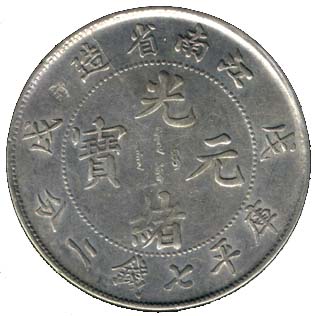
|
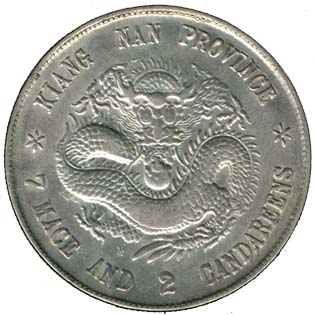
|
No. 127 |
|
Diam. 39 mm |
||
|
Fineness. 89% |
||
| Wt. 26.8 g. | ||
| Rareness D | ||
| Mint Evolution and Peculiarity | ||
|
On the obverse of this coin, there are 4 Chinese and 4 Manchu
characters, all reading as Kuang Hsu Yuan Pao in center, within
a beaded circle. Four Chinese characters at top means "Made
by Kiang Nan Province" and below are Chinese Characters
means "Ku-Ping 7 Mace 2 Candareens". The Chinese character
"Pao" is written in the proper way. The date "Wu-Hsu"
(1898AD) taken from the Chinese sexagenary cycle were inscribed
on the both sides of the circle. You can see clearly that there
are two "Chop Marks" just above the date "Wu-Hsu".
[This is a very common practice for Chinese
merchants, they put these marks on the coins to show that they
had checked the weight and fineness of the piece as suitable
for use as money. Because the Chop Marks would cut through that
surface to expose the color of the metal inside the coin. Chinese
marchants would expose those being chopped copper coins with
plated silver surface.] I think "Chop Marks"
affect the value of the silver coin much, thought they can make
the coin more interesting. But this all depends on how the individual
collector feels. On the reverse there is a side view dragon surrounded by English characters "KIANG NAN PROVINCE, 7 MACE AND 2 CANDAREENS" and stars on the right and left. Please pay more attention at the fireball beneath the dragon's chin, you have hardly seen the 7 flames which normally appeared on the fireball of the Chinese dragon coins. This is a special design of coiled dragon pattern which I like it more. |
||
| Obverse | Reverse | Description |
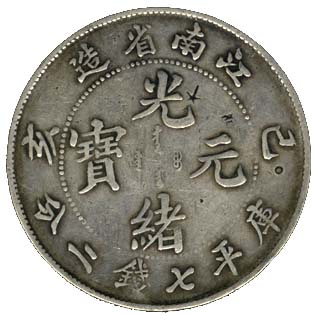
|
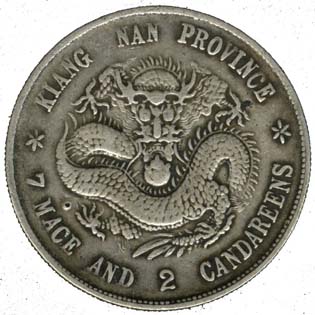
|
No. 186 |
|
Diam. 38 mm |
||
|
Fineness 88% |
||
| Wt. 26.6 g. | ||
| Rareness D | ||
| Mint Evolution and Peculiarity | ||
|
The design of this Kiang Nan coin is similar to the previous
coin except the date "Chi-Hai" (1899AD). The dragon
pattern design is known as Lao Lung ¦ÑÀs [means old dragon] by the Chinese collectors. About ten years ago, I wanted to pubchase a "Wu-Hsu" Kiangnan silver coin, because I knew that the "Wu-Hsu" coin was designed with a "Lao Lung" pattern which I like more. I asked the dealer whether he had the "Lao Lung" Kiangnan silver coin, he turned his head and tell me he did not have. Actually, he misunderstood that I needed a "Lao Kiang Nan" silver coin, but he showed me this coin later and promised to me with a special price. I was very glad to know this new pattern of Chi-Hai coin. Later I have not met this type of silver coin again in Hong Kong. According to the Chinese numismatic references, this coin is not a rare coin. It is strange why I cannot find it again. Actually, the Chi-Hai coin had been changed to a new design pattern in the same year (1899AD). "Lao Kiang Nan" is a very rare silver coin with the dragon pattern in a circle, minted in Kiangnan province in 1897. |
||
| Obverse | Reverse | Description |
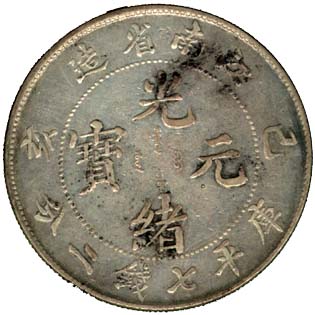
|
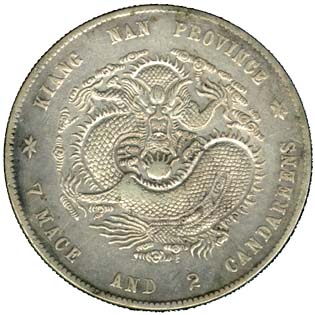
|
No. 128 |
|
Diam. 38 mm |
||
|
Fineness 88% |
||
| Wt. 26.6 g. | ||
| Rareness D | ||
| Mint Evolution and Peculiarity | ||
|
The design of this "Chi-Hai" (1899AD) coin is similar
to the previous coin except the dragon pattern design (new design
pattern). This coin was minted in Nanking Mint too. Perhaps you
don't know where is the Kiangnan Province in China. Because Kiangnan
Province was divided into 2 provinces "An-Hui" and
"Kiang-Su" Provinces in the 6th year of the K'ang Hsi
reign (1667AD). But Chinese accustomed to call An-Hui and Kiang-Su
areas as "Kiangnan". Nanking Mint was established by |
||
| Obverse | Reverse | Description |
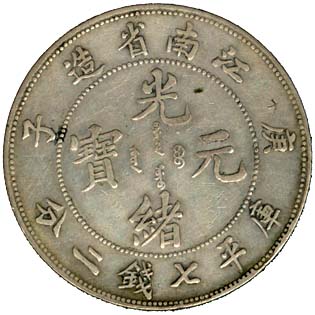
|
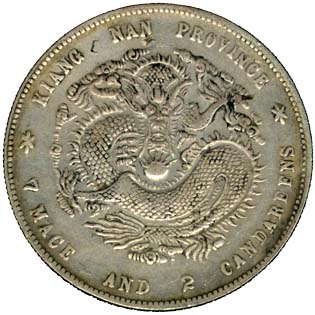
|
No. 129 |
|
Diam. 38.5 mm |
||
|
Fineness 88% |
||
| Wt. 26.7 g. | ||
| Rareness D | ||
| Mint Evolution and Peculiarity | ||
| This coin was minted in the 26th year (1900AD) of the Kuang Hsu reign of the Qing Dynasty. This coin was struck same as other Chinese dragon coins in 5 denominations including 7.2 mace, 3.6 mace, 1.44 mace, 7.2 candareens and 3.6 candareens. The design format is similar to other Kiangnan silver coins. The center of the obverse bears the name of the coin in Chinese and Manchu characters, [The Manchu scripts bearing in the center sometimes are large, like this coin and sometimes are rather small, like the above and below coins, you cannot see them clearly] with the name Kiangnan Province above it and face value below it, and the date ("Keng-Tze" means 1900AD for this coin) flanking on both side. The reverse bears a different dragon pattern in the centre, the mint name, the face value and 2 decorative stars around the central dragon pattern. Kiangnan dragon coins always have different editions in dragon pattern design, even those were minted in the same year. | ||
| Obverse | Reverse | Description |
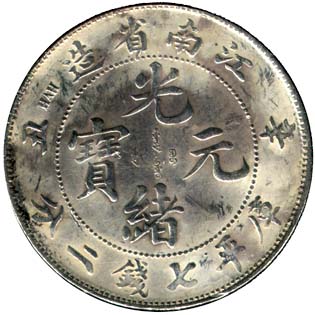
|
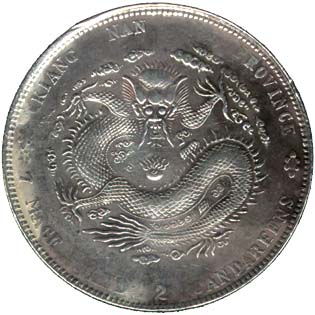
|
No. 187 |
|
Diam. 39 mm |
||
|
Fineness. 88% |
||
| Wt. 27.2 g. | ||
| RarenessD | ||
| Mint Evolution and Peculiarity | ||
| This Hsin Chou (1901AD) Kiangnan silver coin had been improperly cleaned with some acid by the hawker before it was sold to me. This is a typical example of cleaning coins the wrong way which have reduced its value significantly. The hawker thought that a coin in "newer" condition is worth more than an old, dirty one. When the hawker found that a bright old coin does not look natural at all, he put some Chinese ink on the surface of the coin. It is doubly pity that it look even worse as it was placed before me. | ||